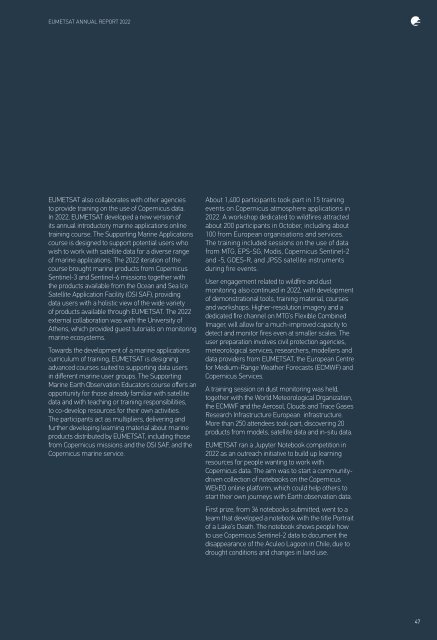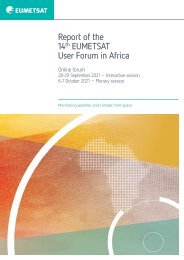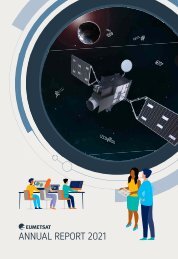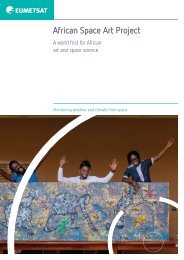EUMETSAT Annual Report 2022
Create successful ePaper yourself
Turn your PDF publications into a flip-book with our unique Google optimized e-Paper software.
<strong>EUMETSAT</strong> ANNUAL REPORT <strong>2022</strong><br />
<strong>EUMETSAT</strong> also collaborates with other agencies<br />
to provide training on the use of Copernicus data.<br />
In <strong>2022</strong>, <strong>EUMETSAT</strong> developed a new version of<br />
its annual introductory marine applications online<br />
training course. The Supporting Marine Applications<br />
course is designed to support potential users who<br />
wish to work with satellite data for a diverse range<br />
of marine applications. The <strong>2022</strong> iteration of the<br />
course brought marine products from Copernicus<br />
Sentinel-3 and Sentinel-6 missions together with<br />
the products available from the Ocean and Sea Ice<br />
Satellite Application Facility (OSI SAF), providing<br />
data users with a holistic view of the wide variety<br />
of products available through <strong>EUMETSAT</strong>. The <strong>2022</strong><br />
external collaboration was with the University of<br />
Athens, which provided guest tutorials on monitoring<br />
marine ecosystems.<br />
Towards the development of a marine applications<br />
curriculum of training, <strong>EUMETSAT</strong> is designing<br />
advanced courses suited to supporting data users<br />
in different marine user groups. The Supporting<br />
Marine Earth Observation Educators course offers an<br />
opportunity for those already familiar with satellite<br />
data and with teaching or training responsibilities,<br />
to co-develop resources for their own activities.<br />
The participants act as multipliers, delivering and<br />
further developing learning material about marine<br />
products distributed by <strong>EUMETSAT</strong>, including those<br />
from Copernicus missions and the OSI SAF, and the<br />
Copernicus marine service.<br />
About 1,400 participants took part in 15 training<br />
events on Copernicus atmosphere applications in<br />
<strong>2022</strong>. A workshop dedicated to wildfires attracted<br />
about 200 participants in October, including about<br />
100 from European organisations and services.<br />
The training included sessions on the use of data<br />
from MTG, EPS-SG, Modis, Copernicus Sentinel-2<br />
and -5, GOES-R, and JPSS satellite instruments<br />
during fire events.<br />
User engagement related to wildfire and dust<br />
monitoring also continued in <strong>2022</strong>, with development<br />
of demonstrational tools, training material, courses<br />
and workshops. Higher-resolution imagery and a<br />
dedicated fire channel on MTG’s Flexible Combined<br />
Imager, will allow for a much-improved capacity to<br />
detect and monitor fires even at smaller scales. The<br />
user preparation involves civil protection agencies,<br />
meteorological services, researchers, modellers and<br />
data providers from <strong>EUMETSAT</strong>, the European Centre<br />
for Medium-Range Weather Forecasts (ECMWF) and<br />
Copernicus Services.<br />
A training session on dust monitoring was held,<br />
together with the World Meteorological Organization,<br />
the ECMWF and the Aerosol, Clouds and Trace Gases<br />
Research Infrastructure European infrastructure.<br />
More than 250 attendees took part, discovering 20<br />
products from models, satellite data and in-situ data.<br />
<strong>EUMETSAT</strong> ran a Jupyter Notebook competition in<br />
<strong>2022</strong> as an outreach initiative to build up learning<br />
resources for people wanting to work with<br />
Copernicus data. The aim was to start a communitydriven<br />
collection of notebooks on the Copernicus<br />
WEkEO online platform, which could help others to<br />
start their own journeys with Earth observation data.<br />
First prize, from 36 notebooks submitted, went to a<br />
team that developed a notebook with the title Portrait<br />
of a Lake’s Death. The notebook shows people how<br />
to use Copernicus Sentinel-2 data to document the<br />
disappearance of the Aculeo Lagoon in Chile, due to<br />
drought conditions and changes in land use.<br />
47









